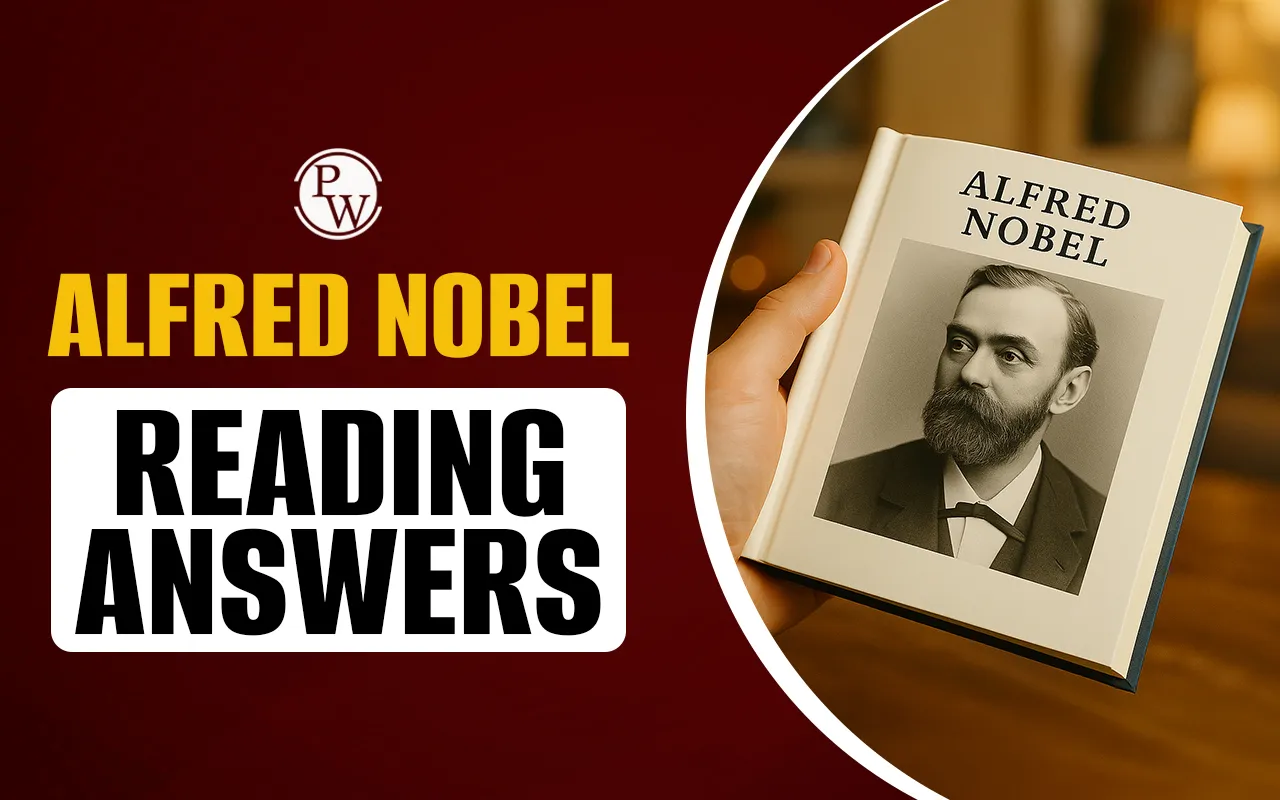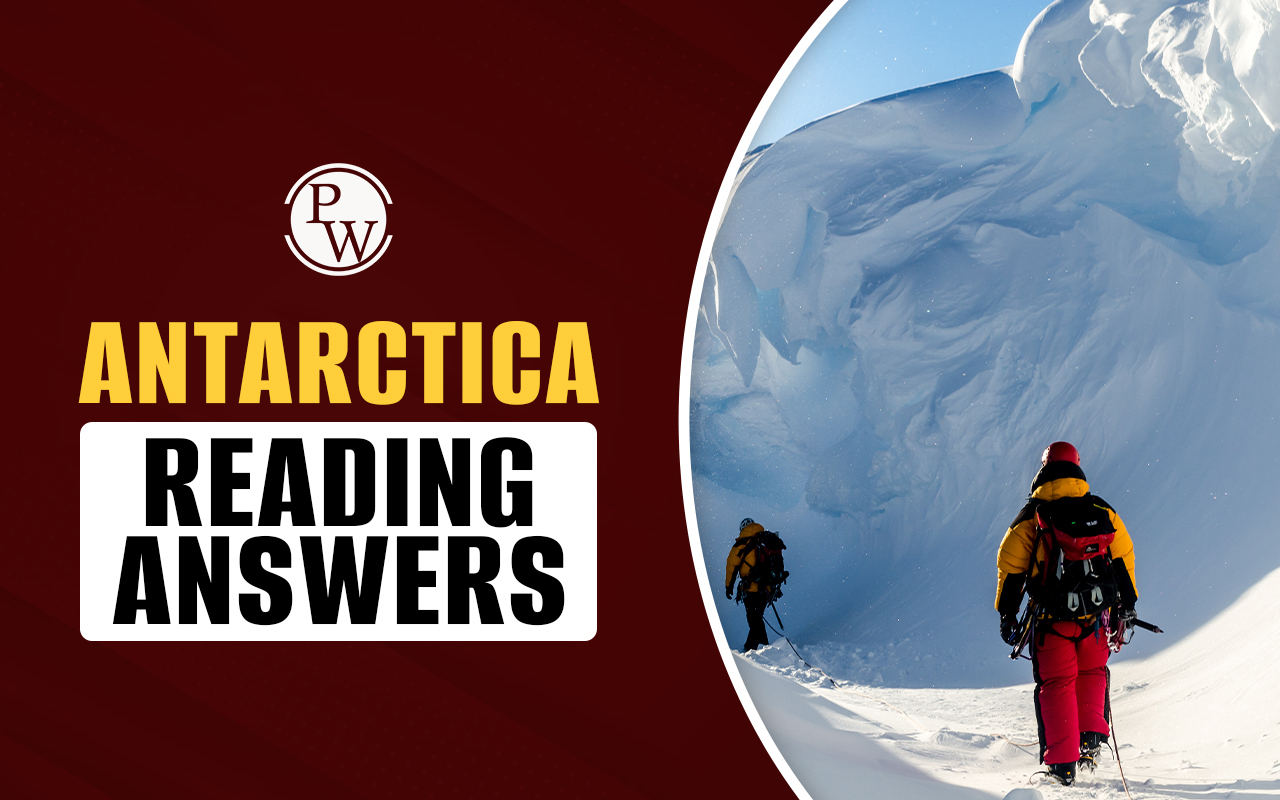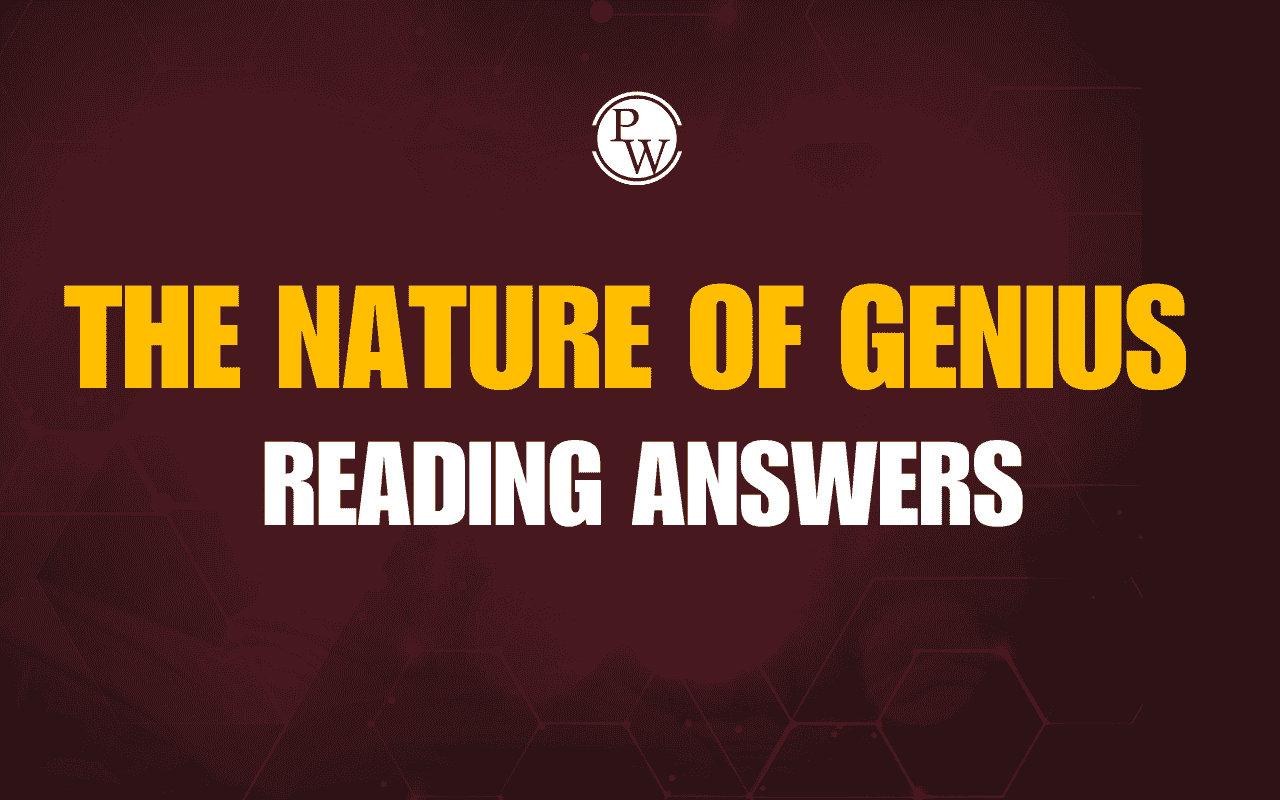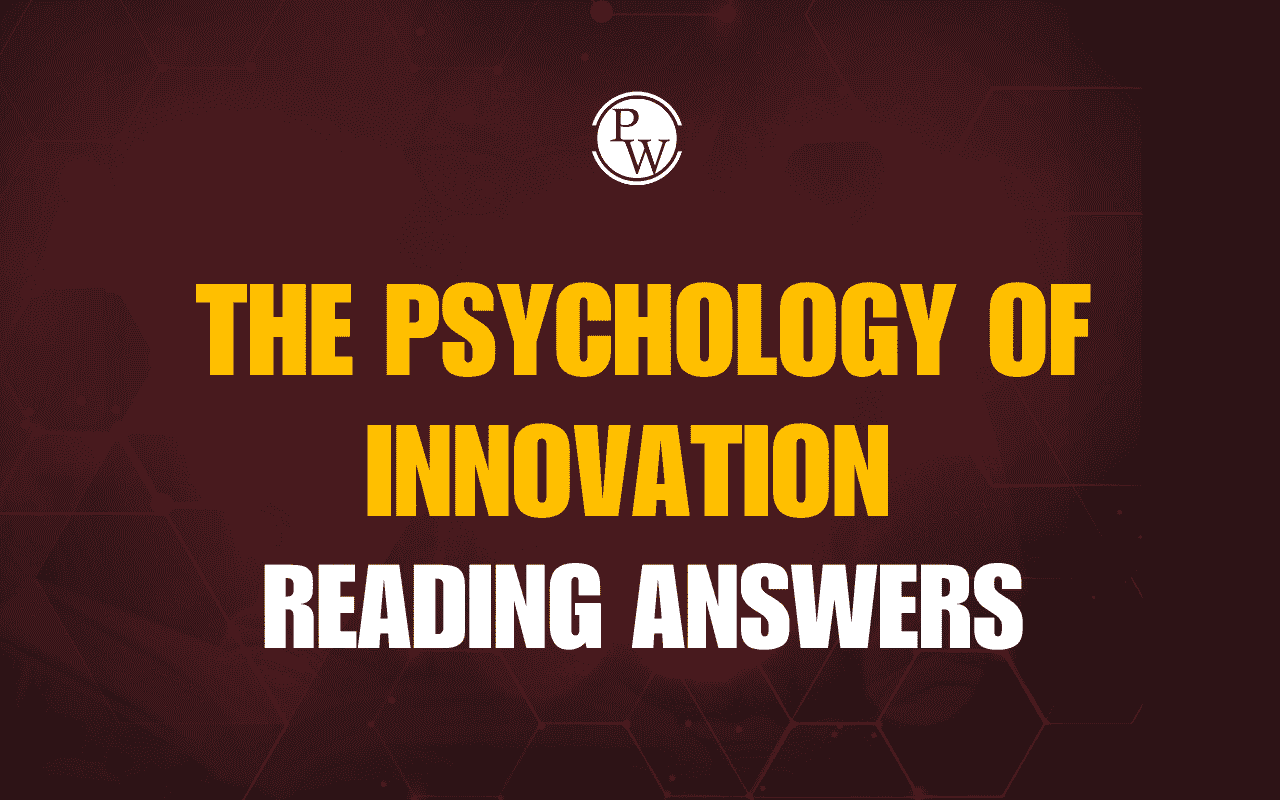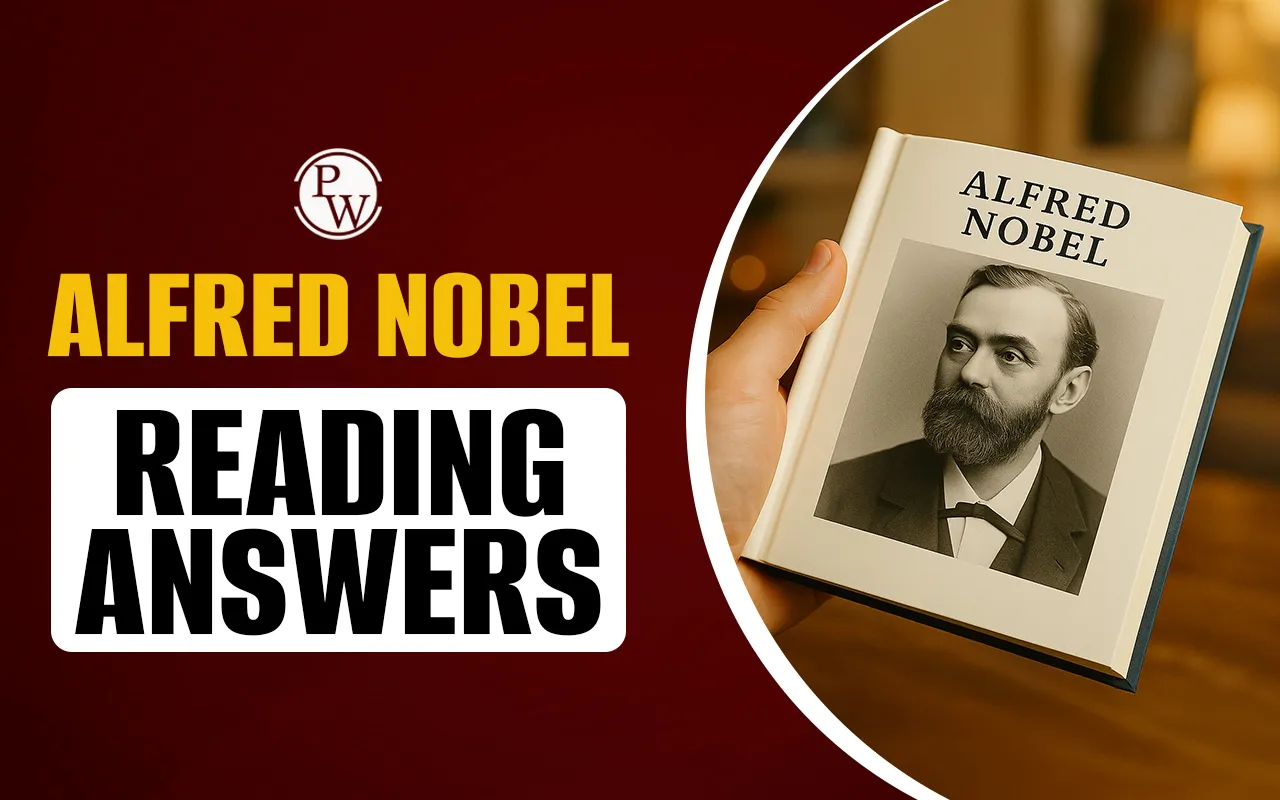
Alfred Nobel Reading Answers: The IELTS reading passage on Alfred Nobel offers insights into the life of one of history’s most impactful scientists and philanthropists. As IELTS reading tests often cover famous personalities, this passage is an excellent preparation resource. Aspirants must understand the Alfred Nobel IELTS reading explanation and solve the questions to improve their problem-solving skills.
To strengthen candidates' exam preparation, this guide provides detailed passage, IELTS based questions, and tips on how to solve IELTS reading passage on the founder of Nobel Prize. To get familiar with the exam environment, candidates must attempt the passage within a set timeline.
IELTS Online Coaching 2025, Free Courses for Study
Alfred Nobel Reading Answers IELTS Passage
Here is the IELTS reading passage on Alfred Nobel. Students must carefully read the passage to accurately answer the related questions.
IELTS Passage on Alfred Nobel
A Since 1901, the Nobel Prize has been honoring men and women from all corners of the globe for outstanding achievements in physics, chemistry, medicine, literature, and for work in peace. The foundations for the prize were laid in 1895 when Alfred Nobel wrote his last will, leaving much of his wealth to the establishment of the Nobel Prize.
B Alfred Nobel was born in Stockholm on October 21, 1833. His father Immanuel Nobel was an engineer and inventor who built bridges and buildings in Stockholm. In connection with his construction work, Immanuel Nobel also experimented with different techniques for blasting rocks. Successful in his industrial and business ventures, Immanuel Nobel was able, in 1842, to bring his family to St. Petersburg. There, his sons were given a first-class education by private teachers. The training included natural sciences, languages and literature. By the age of 17, Alfred Nobel was fluent in Swedish, Russian, French, English and German. His primary interests were in English literature and poetry as well as in chemistry and physics. Alfred's father, who wanted his sons to join his enterprise as engineers, disliked Alfred's interest in poetry and found his son rather introverted.
C In order to widen Alfred's horizons, his father sent him abroad for further training in chemical engineering. During a two year period, Alfred Nobel visited Sweden, Germany, France and the United States. In Paris, the city he came to like best, he worked in the private laboratory of Professor T. J. Pelouze, a famous chemist. There he met the young Italian chemist Ascanio Sobrero who, three years earlier, had invented nitroglycerine, a highly explosive liquid. But it was considered too dangerous to be of any practical use. Although its explosive power greatly exceeded that of gunpowder, the liquid would explode in a very unpredictable manner if subjected to heat and pressure. Alfred Nobel became very interested in nitroglycerine and how it could be put to practical use in construction work. He also realized that the safety problems had to be solved and a method had to be developed for the controlled detonation of nitroglycerine.
D After his return to Sweden in 1863, Alfred Nobel concentrated on developing nitroglycerine as an explosive. Several explosions, including one (1864) in which his brother Emil and several other persons were killed, convinced the authorities that nitroglycerine production was exceedingly dangerous. They forbade further experimentation with nitroglycerine within the Stockholm city limits and Alfred Nobel had to move his experimentation to a barge anchored on Lake Malaren. Alfred was not discouraged and in 1864 he was able to start mass production of nitroglycerine. To make the handling of nitroglycerine safer Alfred Nobel experimented with different additives. He soon found that mixing nitroglycerine with kieselguhr would turn the liquid into a paste which could be shaped into rods of a size and form suitable for insertion into drilling holes. In 1867 he patented this material under the name of dynamite. To be able to detonate the dynamite rods he also invented a detonator (blasting cap) which could be ignited by lighting a fuse. These inventions were made at the same time as the pneumatic drill came into general use. Together these inventions drastically reduced the cost of blasting rock, drilling tunnels, building canals and many other forms of construction work.
E The market for dynamite and detonating caps grew very rapidly and Alfred Nobel also proved himself to be a very skillful entrepreneur and businessman. Over the years he founded factories and laboratories in some 90 different places in more than 20 countries. Although he lived in Paris much of his life he was constantly traveling. When he was not traveling or engaging in business activities Nobel himself worked intensively in his various laboratories, first in Stockholm and later in other places. He focused on the development of explosives technology as well as other chemical inventions including such materials as synthetic rubber and leather, artificial silk, etc. By the time of his death in 1896, he had 355 patents.
F Intensive work and travel did not leave much time for private life. At the age of 43, he was feeling like an old man. At this time he advertised in a newspaper "Wealthy, highly-educated elderly gentleman seeks the lady of mature age, versed in languages, as secretary and supervisor of household." The most qualified applicant turned out to be an Austrian woman, Countess Bertha Kinsky. After working a very short time for Nobel she decided to return to Austria to marry Count Arthur von Suttner. In spite of this Alfred Nobel and Bertha von Suttner remained friends and kept writing letters to each other for decades. Over the years Bertha von Suttner became increasingly critical of the arms race. She wrote a famous book, Lay Down Your Arms and became a prominent figure in the peace movement. No doubt this influenced Alfred Nobel when he wrote his final will which was to include a Prize for persons or organizations who promoted peace. Several years after the death of Alfred Nobel, the Norwegian Storting (Parliament) decided to award the 1905 Nobel Peace Prize to Bertha von Suttner.
G Alfred Nobel died in San Remo, Italy, on December 10, 1896. When his will was opened it came as a surprise that his fortune was to be used for Prizes in Physics, Chemistry, Physiology or Medicine, Literature and Peace. The executors of his will were two young engineers, Ragnar Sohlman and Rudolf Lilljequist. They set about forming the Nobel Foundation as an organization to take care of the financial assets left by Nobel for this purpose and to coordinate the work of the Prize-Awarding Institutions. This was not without its difficulties since the will was contested by relatives and questioned by authorities in various countries.
H Alfred Nobel's greatness lay in his ability to combine the penetrating mind of the scientist and inventor with the forward-looking dynamism of the industrialist. Nobel was very interested in social and peace-related issues and held what were considered radical views in his era. He had a great interest in literature and wrote his own poetry and dramatic works. The Nobel Prizes became an extension and a fulfillment of his lifetime interests.
- IELTS exam eligibility requirements
- Documents Required for IELTS Registration
- IELTS Test Slot Booking
Alfred Nobel Reading Answers IELTS Questions
Here are various types of IELTS questions based on Alfred Nobel reading passage provided above. Students are recommended to read each question to understand its requirements and answer it accordingly.
Questions 1-7: True/False/Not Given
1. Alfred Nobel established the Nobel Prize during his lifetime.
2. Alfred Nobel was multilingual by the age of 17. 3. Nitroglycerine was invented by Alfred Nobel.
4. The invention of dynamite made construction work more expensive.
5. Alfred Nobel had more than 300 patents at the time of his death.
6. Bertha von Suttner won the Nobel Peace Prize in 1905.
7. Alfred Nobel's relatives supported his will unconditionally.
Questions 8-13: Multiple Choice
8. Alfred Nobel's father wanted him to:
a) Become a poet
b) Study literature
c) Work as an engineer
d) Move to Paris
9. The main problem with nitroglycerine was that it:
a) Was not powerful enough
b) Exploded unpredictably
c) Was too expensive to produce
d) Could not be transported
10. Alfred Nobel moved his experiments to a barge because:
a) He needed more space
b) It was cheaper
c) Authorities banned city experiments
d) His brother was killed
11. Dynamite was created by mixing nitroglycerine with:
a) Gunpowder
b) Water
c) Kieselguhr
d) Rubber
12. How many countries did Nobel establish factories in?
a) 90
b) More than 20
c) 355
d) The text doesn't specify
13. Alfred Nobel died in:
a) Stockholm, Sweden
b) Paris, France
c) St. Petersburg, Russia
d) San Remo, Italy
Questions 14-19: Summary Completion
Complete the summary using words from the passage (maximum 2 words for each answer):
Alfred Nobel was born in (14)_______ in 1833. His father was an (15)_______ and inventor. Nobel received his education from (16)_______ and became fluent in five languages. He developed an interest in nitroglycerine after meeting (17), who had invented this explosive liquid. Nobel solved the safety problems by creating (18), which he patented in 1867. Nobel's correspondence with (19)_______ influenced his decision to include a peace prize in his will.
What are the IELTS Reading Answers for Alfred Nobel?
Here are the IELTS reading answers for Alfred Nobel’s life passage based questions. Once students complete all practice questions on their own, they should analyse their performance with the following answers:
Answers 1-7: True/False/Not Given
1. False (The passage states that Nobel wrote his will in 1895, but the prizes have been awarded since 1901. He died in 1896, so he didn't establish them during his lifetime.)
2. True (Paragraph B clearly states that by the age of 17, Alfred Nobel was fluent in Swedish, Russian, French, English and German.)
3. False (Paragraph C mentions that Ascanio Sobrero had invented nitroglycerine, a highly explosive liquid, three years before Nobel met him.)
4. False (Paragraph D states that Nobel's inventions drastically reduced the cost of blasting rock, drilling tunnels, building canals and many other forms of construction work.)
5. True (Paragraph E mentions that by the time of his death in 1896, he had 355 patents.)
6. True (Paragraph F states that the Norwegian Storting (Parliament) decided to award the 1905 Nobel Peace Prize to Bertha von Suttner.)
7. False (Paragraph G states that the will was contested by relatives and questioned by authorities in various countries.)
Answers 8-13: Multiple Choice
8. C) Work as an engineer (In paragraph B it is written that Alfred's father, who wanted his sons to join his enterprise as engineers.)
9. B) Exploded unpredictably (Paragraph C states that the liquid would explode in a very unpredictable manner if subjected to heat and pressure.)
10. C) Authorities banned city experiments (Paragraph D states that they forbade further experimentation with nitroglycerine within the Stockholm city limits.)
11. C) Kieselguhr (Paragraph D mentions that mixing nitroglycerine with kieselguhr would turn the liquid into a paste.)
12. B) More than 20 (Paragraph E states that he founded factories and laboratories in some 90 different places in more than 20 countries.)
13. D) San Remo, Italy (Paragraph G begins with, Alfred Nobel died in San Remo, Italy, on December 10, 1896.)
Answers 14-19: Summary Completion
14. Stockholm (Paragraph B says, Alfred Nobel was born in Stockholm on October 21, 1833.)
15. engineer (Paragraph B includes, his father Immanuel Nobel was an engineer and inventor.)
16. private teachers (In paragraph B it is written that his sons were given a first-class education by private teachers.)
17. Ascanio Sobrero (Paragraph C says, tThere he met the young Italian chemist Ascanio Sobrero.)
18. dynamite (Paragraph D states that, in 1867 he patented this material under the name of dynamite.)
19. Bertha von Suttner (Paragraph F mentions Alfred Nobel, and Bertha von Suttner remained friends and kept writing letters to each other for decades.)
How to Approach the IELTS Reading on Nobel Prize History?
When solving IELTS questions based on biographical passages like the Alfred Nobel, students adhere to the following strategies:
-
Skim through the Alfred Nobel reading passage to get an overview of the structure.
-
Identify key dates such as Nobel’s birth year, dynamite development, year of death, and more.
-
Understand cause and effect, such as how personal experiences influenced Nobel’s final will.
-
Highlight Nobel’s connection with Bertha von Suttner and its importance for the Peace Prize.
-
Understand the technical details mentioned in the passage, the development process from nitroglycerine to dynamite.
-
Set a timeline to complete the questions. Ideally, students should dedicate 15 minutes to solving the questions, 3 minutes to reading the passage, and 2 minutes for revision.
Guidance of PW IELTS
Physics Wallah offers a few popular online IELTS courses for all students. Follow the latest IELTS articles to better prepare for the exam.
| IELTS Registration | IELTS Eligibility Criteria |
| IELTS Exam Pattern | IELTS Syllabus |
| IELTS Exam Dates | IDP IELTS Test Centers |
Alfred Nobel Reading Answers FAQs
How many question in Alfred Nobel IELTS passage?
What types of questions are asked in the Alfred Nobel IELTS reading test?
What is the most difficult part of the IELTS reading?
How to increase IELTS reading speed?

